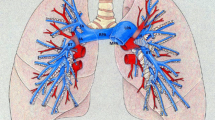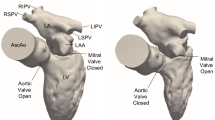Abstract
Previous in vitro studies have shown that total cavopulmonary connection (TCPC) models incorporating offset between the vena cavae are energetically more efficient than those without offsets. In this study, the impact of reducing simplifying assumptions, thereby producing more physiologic models, was investigated by computational fluid dynamics (CFD) and particle flow visualization experiments. Two models were constructed based on angiography measurements. The first model retained planar arrangement of all vessels involved in the TCPC but incorporated physiologic vessel diameters. The second model consisted of constant-diameter vessels with nonplanar vascular features. CFD and in vitro experiments were used to study flow patterns and energy losses within each model. Energy losses were determined using three methods: theoretical control volume, simplified control volume, and velocity gradient based dissipation. Results were compared to a simplified model control. Energy loss in the model with physiologically more accurate vessel diameters was 150% greater than the simplified model. The model with nonplanar features produced an asymmetric flow field with energy losses approximately 10% higher than simplified model losses. With the velocity gradient based dissipation technique, the map of energy dissipation was plotted revealing that most of the energy was dissipated near the pulmonary artery walls. © 2001 Biomedical Engineering Society.
PAC01: 8719Uv, 8710+e, 8780-y
Similar content being viewed by others
REFERENCES
Bird, R., W. Stewart, and E. Lightfoot. Transport Phenomena. New York: Wiley, 1960.
Currie, I. G. Fundamental Mechanics of Fluids. New York: McGraw-Hill, 1993.
de Leval, M. R., P. Kilner., M. Gewillig., and C. Bull. Total cavopulmonary connection: A logical alternative to atriopulmonary connection for complex Fontan operations. Experimental studies and early clinical experience. J. Thorac. Cardiovasc. Surg.96.:682–695., 1988.
de Leval, M. R., G. Dubini., F. Migliavacca., H. Jalali., G. Camporini., A. Redington., and R. Pietrabissa. Use of computational fluid dynamics in the design of surgical procedures: Application to the study of competitive flows in cavopulmonary connections. J. Thorac. Cardiovasc. Surg.111.:502–513., 1996.
Dubini, G., M. de Leval., R. Pietrabissa., F. Montevecchi., and R. Fumero. A numerical fluid mechanical study of repaired congenital heart defects: Application to the total cavopulmonary connection. J. Biomech.29.:111–121., 1996.
Ensley, A., P. Lynch., G. Chatzimavroudis., C. Lucas., S. Sharma., and A. Yoganathan. Toward designing the optimal total cavopulmonary connection: An in vitro. study. Ann. Thorac. Surg.68.:1384–1390., 1999.
Ensley, A., A. Ramuzat., T. Healy., G. Chatzimavroudis., C. Lucas., S. Sharma., R. Pettigrew., and A. Yoganathan. Fluid mechanic assessment of the total cavopulmonary connection using magnetic resonance phase velocity mapping and digital particle image velocimetry. Ann. Biomed. Eng.28.:1172–1183., 2000.
Fontan, F., and E. Baudet. Surgical repair of tricuspid atresia. Thorax.26.:240–248., 1971.
Gerdes, A., J. Kunze., G. Pfister., and H. Sievers. Addition of a small curvature reduces power losses across total cavopulmonary connections. Ann. Thorac. Surg.67.:1760–1764., 1999.
Healy, T., C. Lucas., and A. Yoganathan. Noninvasive fluid dynamic power loss assessments for total cavopulmonary connections using the viscous dissipation function: A feasibility study. J. Biomech. Eng.123.:317–324., 2001.
Migliavacca, F., M. de Leval., G. Dubini., R. Pietrabissa., and R. Fumero. Computational fluid dynamic simulations of cavopulmonary connections with an extracardiac lateral conduit. Med. Eng. Phys.21.:187–193., 1999.
Migliavacca, F., P. Kilner., G. Pennati., G. Dubini., R. Pietrabissa., R. Fumero., and M. de Leval. Computational fluid dynamic and magnetic resonance analyses of flow distribution between the lungs after total cavopulmonary connection. IEEE Trans. Biomed. Eng.46.:393–399., 1999.
Migliavacca, F., M. de Leval., G. Dubini., and R. Pietrabissa. A computational pulsatile model of the bidirectional cavopulmonary anastomosis: The influence of pulmonary forward flow. J. Biomech. Eng.118.:520–528., 1996.
Sharma, S., S. Goudy., P. Walker., S. Panchal., A. Ensley., K. Kanter., V. Tam., D. Fyfe., and A. Yoganathan. In vitro. flow experiments for determination of optimal geometry of total cavopulmonary connection for surgical repair of children with functional single ventricle. J. Am. Coll. Cardiol.27.:1264–1269., 1996.
Sheu, T. W. H., S. F. Tsai., W. S. Hwang., and T. M. Chang. A finite element study of the blood flow in the total cavopulmonary connection. Comput. Fluids.28.:19–39., 1999.
Shoemaker, D. P., C. W. Garland, and J. W. Nibler. Experiments in Physical Chemistry. New York: McGraw-Hill, 1989.
Author information
Authors and Affiliations
Rights and permissions
About this article
Cite this article
Ryu, K., Healy, T.M., Ensley, A.E. et al. Importance of Accurate Geometry in the Study of the Total Cavopulmonary Connection: Computational Simulations and In Vitro Experiments. Annals of Biomedical Engineering 29, 844–853 (2001). https://doi.org/10.1114/1.1408930
Issue Date:
DOI: https://doi.org/10.1114/1.1408930




